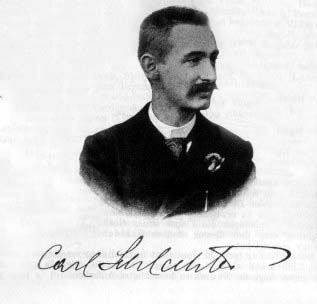
Edward Winter
The present article comprises a compendium of C.N. items about Carl Schlechter (1874-1918) which are not included in The Lasker v Schlechter Controversy (1910) and Fleissig v Schlechter, Vienna, 1893.
**
Many sources refer to ‘Karl’, rather than Carl, Schlechter. Indeed, both the Spielmann and Petrović monographs use ‘Karl’ in their titles.
Page 8 of the January-February 1907 Wiener Schachzeitung has his signature – clearly Carl.
(1668)

See also C.N. 3686.
A death in 1992 that has gone unrecorded is that of Warren H. Goldman, in Heidelberg on 26 June 1992. Apart from New Ideas in Old Settings (an examination of 1 e4 c6 2 Nc3 d5 3 Qf3, published privately in 1958 and by CHESS, Sutton Coldfield in 1977), his best-known contribution to chess literature was a series of fine tournament books (Vienna, 1890; Berlin, 1897; Tamesvar, 1912). W.H.G.’s magnum opus has yet to appear: a monograph on Carl Schlechter which, his widow informs us, he finished writing the evening before he was taken ill. Over the years, Mr Goldman often showed us sample chapters, and we greatly look forward to the publication of a biography/games collection of remarkable quality.
(1974)
Carl Schlechter! Life and Times of the Austrian Chess Wizard by Warren Goldman (Yorklyn, 1994) is a posthumous work of 537 pages in which the author presents an extraordinarily detailed account of a master too easily remembered solely for his drawn match against Lasker in 1910. As noted on page 51, Lasker wrote of Schlechter: ‘He knows every part of the game, opening, middle and particularly the ending. All adjectives apply to his style; it is bold and cautious, straightforward and trappy, complicated and simple, hard to define, and withal personal’.
When we once remarked to Warren Goldman that our favourite Schlechter game was his win against Walter John at Barmen, 1905, he told us that his own choice was the ‘heroic defence’ masterpiece against Schiffers (Vienna, 1898). Since both games are well known, we choose a lighter battle here:
Cavera – Carl Schlechter
Milan, 3 June 1901
Philidor’s Defence
1 e4 e5 2 Nf3 d6 3 d4 f5 4 dxe5 fxe4 5 Ng5 d5 6 Nc3 c6 7 f4 Nh6 8 Be2 Be7 9 h4 O-O 10 Bh5 Qb6 11 g4 Nd7 12 e6
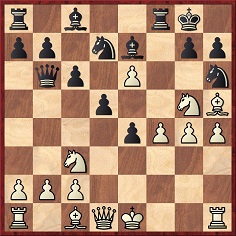
12...Ne5 13 Bf7+ Nhxf7 14 exf7+ Rxf7 15 Nxf7 Nf3+ 16 Kf1 Bxg4 17 Nxd5 cxd5 18 Qxd5 Bh3+ 19 Ke2 Be6 20 Qxe4 Nd4+ 21 Kd1 Bg4+ 22 Ke1 Bxh4+ 23 Kf1 Be2+ 24 Kg1 Nf3+ 25 Kg2 Qf2+ 26 White resigns.
This handsome hardback is extensively illustrated with rare photographs and documents. Sixty pages are devoted to analysing the games of the world championship match against Lasker and the controversy regarding the conditions under which it was fought.
It is hard to imagine any chess enthusiast who would not treasure this enchanting book.
(2077)
Schlechter’s compositions were discussed on pages 74-78 of Warren Goldman’s book Carl Schlechter! Life and Times of the Austrian Chess Wizard, which put at about 200 the number of problems probably composed by the Viennese master. A selection of 20 of them was included in the book, and here is another one:
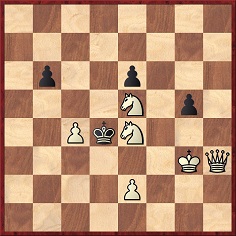
Mate in three
Source: Wiener Schachzeitung, December 1910, page 420.
(2300)
Daniël De Mol (Wetteren Belgium) is surprised by the remark about problems on page 75 of Goldman’s book on Schlechter (‘there are, perhaps, more than 150 of these – but no collection has ever been published’). Our correspondent points out that the 1920 monograph Carl Schlechter, sein Leben und Schaffen contains no fewer than 90 two-movers and 81 three-movers.
The explanation is that Goldman’s book wrongly presented the above words as if they were his own. In fact, he was more or less quoting the information provided by Alain C. White to William M. Russell for an article published on pages 63-68 of the March 1919 American Chess Bulletin, i.e. the year before the German work on Schlechter was published.
(2315)
From page 42 of Carl Schlechter! Life and Times of the Austrian Chess Wizard by Warren Goldman:
‘The press of his Handbuch duties nevertheless prevented him from accepting invitations to play in the two great events of that year – St Petersburg (Russia) and Mannheim (Germany).’
Reuben Fine on page 240 of Chess Review, August-September 1943:
‘The only active top-notcher missing [from St Petersburg, 1914] was Schlechter (the story is that he meant to play but absent-mindedly took the wrong train).’
(4943)
A Christmas card (1991) from Warren Goldman stated that he expected the Schlechter book to be published the following year, and below is an extract from his final letter to us, dated 6 March 1992:
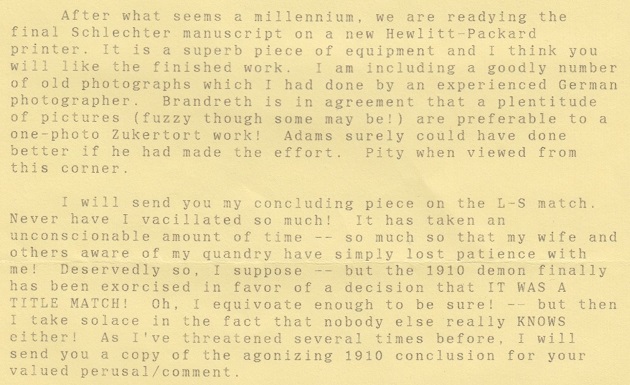
On 5 January 1993 Hildegard Goldman wrote to us:
‘... my dear husband passed away last 26 June after suffering a light stroke, followed, while in the head clinic of the University of Heidelberg, by complications and heart failure after days in the intensive care unit of the clinic. My only solace is that he did not suffer ...’
Regarding Warren Goldman’s work as an opening theoretician, see issue 15 of Kaissiber, which carried a photograph of him on the front cover.
(11844)
From page 220 of Schlechter’s Chess Games by Tom Crain (Yorklyn, 1998):
‘Starting back in Pistyan, 1912, up to and including [Vienna, 1915], Schlechter had played 117 competitive tournament games. He lost only twice, once to Tartakower in the Vienna Chess Club anniversary tournament, in 1913, and once to Kaufmann, in Vienna, 1914. An extraordinary record. Even though Lasker had a lower percentage of lost games in his career than Schlechter, Lasker never approached this record. In fact, none of Schlechter’s fin de siècle contemporaries ever approached this record, not Tarrasch, Pillsbury, Maróczy, Rubinstein, no-one. No-one, that is, until Capablanca set his more widely known record. Starting with New York, 1915, up to and including New York, 1924, Capablanca played 112 competitive games (89 tournament games and 23 match games). He lost only twice, once to Chajes in New York, 1916, and the other was his celebrated loss to Réti in New York, 1924. The point is this: not only had Schlechter proved himself Lasker’s equal in 1910, he also proved he was as “invincible” as Capablanca. Schlechter was, indeed, the zwischenzug between the two world champions.’
In fact, Capablanca’s total should read 108, since there were only 19 match games.
(2282)
Two Schlechter games (White against J. Bendiner and Black against L. Fried) were given, as published by us in Kingpin in 1998, on page 117 of Kings, Commoners and Knaves. In an e-mail message dated 10 February 2001 Tom Crain pointed out that they had been published more frequently than we had believed. Moreover, both appeared on page 259 of his book Schlechter’s Chess Games (Yorklyn, 1998).
From Miniature Chess Games (see too page 128 of Kings, Commoners and Knaves):
Even a leading master will occasionally be on the sharp end of a miniature. Carl Schlechter’s quick defeat against a lesser light comes from pages 108-109 of the April 1904 Deutsche Schachzeitung.
Carl Schlechter – Hugo Fähndrich
Vienna, 29 October 1903
Ruy López1 e4 e5 2 Nf3 Nc6 3 Bb5 a6 4 Ba4 Nf6 5 O-O Nxe4 6 d4 b5 7 Bb3 d5 8 dxe5 Be6 9 c3 Bc5 10 a4 Rb8 11 axb5 axb5 12 Nd4 Nxe5 13 Bf4 Ng6 14 Nc6 Qf6 15 Be3 Nh4 16 Bxc5
16...Bh3 17 gxh3 (But not, the Deutsche Schachzeitung says, 17 Qxd5 Nf3+ 18 Kh1 Bxg2+ 19 Kxg2 Nh4+ 20 Kh3 Qf3+ 21 Kxh4 g5+, and Black wins.) 17...Qxc6 18 Bd4 (Here the German magazine recommends 18 Qh5 Nxc5 19 Re1+ Kf8 20 Qxh4 Nxb3 21 Qe7+ Kg8 22 Ra6 Qc5 23 Qd7 h5 24 Rc6 Qf8 25 Rxc7 Rh6 26 Re7.) 18...h5 (To enable the black queen to give check on the g-file without White’s queen being able to interpose at g4.) 19 Kh1 Qg6 20 Rg1 Nxf2+ 21 White resigns. (After 21 Bxf2, Black wins with 21...Qe4+.)
An extract from Missed Mates:
From a tournament game (C. Schlechter v J. Mieses, Leipzig, 13 September 1894):
Black played 30…Qe7, and Schlechter continued with 31 Qh6+. Despite missing the mate in one, he went on to win the game at move 52.
At the Wijk aan Zee, 2000 tournament Kasparov showed aggressive displeasure at the attribution of game prizes, and his behaviour is worth contrasting with Carl Schlechter’s.
From page 19 of The Year-Book of Chess, 1907 here are Gunsberg’s words concerning the Ostend, 1906 tournament:
‘… Schlechter was the one competitor who accepted all things and all arrangements with equanimity amounting almost to indifference. Everything was right for him and nothing amiss, and this man, who apparently paid such little regard to his interests, was the winner of the first prize. Schlechter also showed us the generous side of his nature by declining to compete for any of the brilliancy prizes, for which he undoubtedly would have had the best chance. “I have won enough”, he said. “Let others get something too”.’
(Chess Café, 2000)
Alessandro Nizzola (Mantova, Italy) points out this translator’s note about Schlechter on page 119 of Nimzowitsch’s La Pratica del Mio Sistema (Milan, 1987):
‘For the record: the Austrian master starved to death in his home city of Vienna on Christmas Day 1917.’
For the record: wrong city, wrong country, wrong day, wrong year.
(2396)
A group photograph taken at Coburg, 1904:
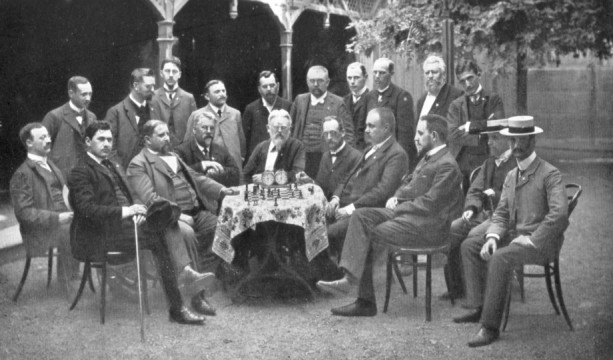
Standing (left to right): C.
Schlechter, H. Ranneforth, R. Swiderski, C. Schröder, A. Schott,
F. Tausch, W. John, H. Süchting, C. Teller, L. Fleischmann.
Seated: J. Mieses, H. Wolf, H. von Gottschall, P. Schellenberg,
R. Gebhardt, J. Berger, G. Marco, O. Bernstein, C. von
Bardeleben, H. Caro.
(3570)
Below is the entry for ‘Remismonde’ on page 171 of Dictionary of Modern Chess by Byrne J. Horton (New York, 1959). Any information confirming, refuting or complementing the entry will be gratefully received.
‘A term coined by Dr Tarrasch (1862-1934) which he applied to [Carl] Schlechter of Vienna. Schlechter was known to have terminated many of his games as drawn games. Hence, Dr Tarrasch referred to him as the “Master of the Vienna Remismonde”.
Literally, “Remismonde” is a compound French word. Remis in chess terminology means a draw. (See Dictionnaire de la Langue Française, by E. Littré, Paris, 1883.) Monde means world. There is no completely satisfactory or precise explanation of this compounded word. Dr Felix Pollak of Northwestern University, a passionate chessplayer from Vienna, offered the following explanation. He wrote: “I believe it is simply a play on words, coining a parallel expression to ‘demi-monde’ (denoting a lady of the ‘half-world’ i.e. of easy virtue). Hence, calling Schlechter the Master of the Remismonde denotes Schlechter to be king of the drawing world, the Master of the Vienna ‘Grand-Master-Drawers’.” Mr Hans Kmoch, the renowned Secretary and Manager of the famous Manhattan Chess Club, concurs with this explanation.’
(4367)
We now note the following on page 63 of the August 1898 American Chess Magazine:
‘Personally, he [Tarrasch] is a gentleman of the world, with the most elegant of manners; genial, sarcastic, witty and sharp-tongued. “Ah!”, he exclaimed once, when the dear Viennese again brought about a “draw”. “I am here in Vienna among the ‘Remismonde’.” “It is not sufficient to be a good chessplayer, one must play good chess”, is one of his favorite sayings.’
The writer was Armin Friedmann in Pester Lloyd, 20 or 21 June 1898. The original German version was given on page 346 of the Vienna, 1898 tournament book:
‘Persönlich ist Dr Tarrasch ein Weltmann von feinsten Manieren, geistreich, boshaft, witzig, scharfzüngig. “Ach ich verkehre hier nur mit der Remismonde”, seufzte er jüngst, als die lieben Wiener nach ihrer Gewohnheit sich wieder einmal ausglichen. “Es ist nicht genug, dass man ein guter Spieler ist, man muss auch gut spielen”, lautet einer seiner Aussprüche.’
Spoof variants on the ‘good chessplayer’ dictum were discussed on pages 396-397 of Kings, Commoners and Knaves, but what earlier citations can be found for Tarrasch’s own words?
(4868)
Calle Erlandsson (Lund, Sweden) sends this group photograph taken during the Stockholm, 1906 tournament, from that year’s Tidskrift för Schack (between page 56 of issue 3 and page 57 of issue 4/5):
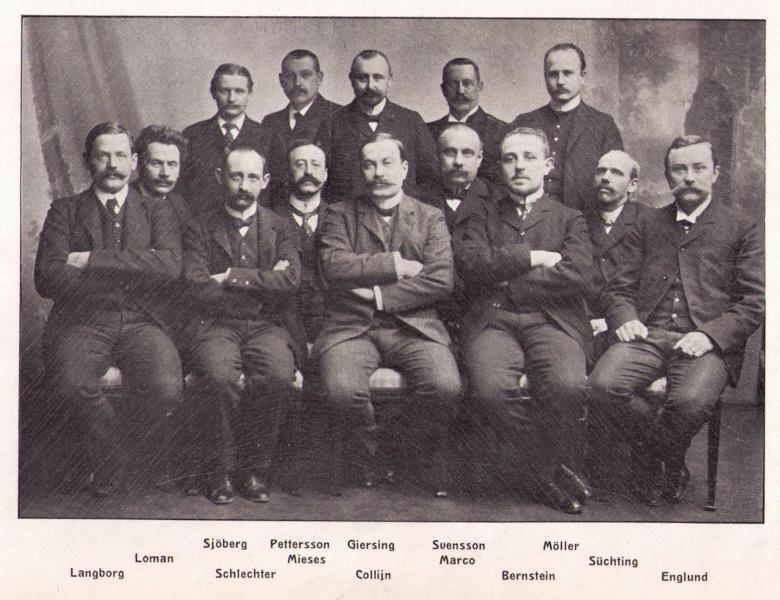
(5221)
John Hilbert (Amherst, NY, USA) sends a pair of chess columns in which Carl Schlechter annotated two of his tournament games apparently now forgotten:
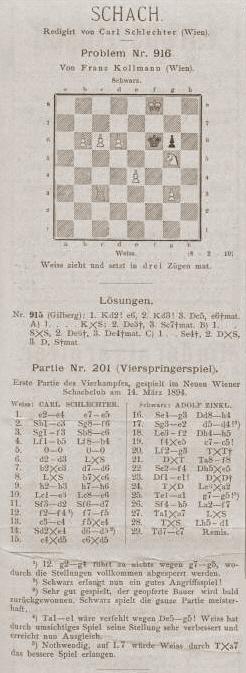
Source: Allgemeine Sport-Zeitung, 25 March 1894, page 279
Carl Schlechter – Adolf Zinkl
Vienna, 14 March 1894
Four Knights’ Game
1 e4 e5 2 Nc3 Nf6 3 Nf3 Nc6 4 Bb5 Bb4 5 O-O O-O 6 d3 Bxc3 7 bxc3 d6 8 Bxc6 bxc6 9 h3 h6 10 Be3 Be6 11 Nd2 Nd7 12 f4 f5 13 c4 fxe4 14 Nxe4 d5 15 cxd5 cxd5 16 Ng3 Qh4 17 Ne2 d4 18 Bf2 Qh5 19 fxe5 c5 20 Bg3 Rxf1+ 21 Qxf1 Rf8
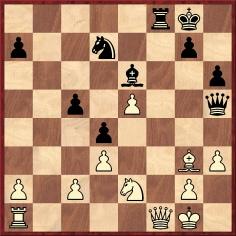
22 Nf4 Qxe5 23 Qe1 Qxe1+ 24 Rxe1 Bxa2 25 Ra1 g5 26 Nh5 Bf7 27 Rxa7 Bxh5 28 Rxd7 Bd1 29 Rc7 Drawn.

Source: Allgemeine Sport-Zeitung, 13 December 1896, page 1391
Carl Schlechter – Jacques Mieses
Vienna, 6 November 1896
King’s Gambit Declined
1 e4 e5 2 f4 Bc5 3 Nf3 d6 4 Nc3 Nc6 5 Bb5 Nf6 6 d3 Ng4 7 Qe2 Bf2+ 8 Kd1 Bb6 9 Rf1 exf4 10 Bxf4 O-O 11 Bxc6 bxc6 12 h3 Nf6 13 Bg5 Ba5 14 Nd4 Bxc3 15 Bxf6 gxf6 16 bxc3 c5 17 Nf5 Bxf5 18 Rxf5 Kh8 19 Qf3 Rg8 20 g4 Rg6
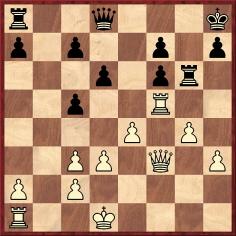
21 Rb1 Qe7 22 c4 Qd8 23 Ke2 Rb8 24 Rb3 a5 25 h4 a4 26 Rxb8 Qxb8 27 h5 Rg8 28 Rxf6 Qb2 29 Rxf7 Qxc2+ 30 Kf1 Qb1+ 31 Kg2 Qxa2+ 32 Kh3 Qa1
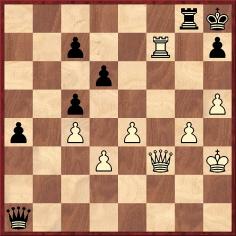
33 Re7 Resigns.
(6575)
Jan Kalendovský (Brno, Czech Republic) notes that the Schlechter v Mieses game was given in an article about Schlechter by Ernst Grünfeld on pages 65-67 of the March 1931 Wiener Schachzeitung.
(6641)
Regarding the Rice Gambit match between Carl Schlechter and Emanuel Lasker (Prague, 1908), see C.N.s 6857, 10781, 10789, 10825 and 10857.
(6857)
Maurice Carter (Fairborn, OH, USA) asks about the location of Carl Schlechter’s remains. His question arises from C.N. 1084, which is reproduced below:
Ludwig Steinkohl (Bad Aibling, Federal Republic of Germany) informs us of a letter he has received from Mr Egon Spitzenberger of Vienna, the Chairman of the Committee for Correspondence Chess of the Austrian Chess Federation, indicating that both Schlechter and his mother were buried in Catholic graveyards (the latter at Perchtoldsdorf, a suburb of Vienna, in the late 1930s).
The reference by Steinkohl to the late 1930s in connection with Schlechter’s mother was corrected in C.N. 1152 when Warren Goldman pointed out this report on page 76 of the March 1925 Wiener Schachzeitung:
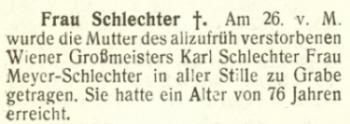
Goldman added that the 1925 death-date was confirmed by church papers about the Schlechter family which were in his possession.
As Mr Carter remarks, the master’s death and burial were subsequently discussed on pages 45-47 of Carl Schlechter! Life and Times of the Austrian Chess Wizard by Warren Goldman (Yorklyn, 1994). It was noted, for instance, that writers such as Schonberg and Horowitz were ‘apparently blissfully unaware that Schlechter died in Budapest’ (as opposed to Vienna). In this connection, see the first item in Chess and Untimely Death Notices.
Schlechter was buried in Budapest, and a footnote on page 47 of Goldman’s book reads:
‘A last word concerning Schlechter’s final resting place: during a 1984 visit to Budapest, Herbert Huber of Vienna learned that the “honor grave” of 1918 no longer exists – the burial site in the Rakoskeressturer Cemetery having been closed by the Hungarian authorities some years ago. Whether Schlechter’s remains were moved to another location is unknown to the author.’
The discussion concerning Schlechter originated in C.N. 1055, where we noted the deletion of his name as a Jew in some versions of the anti-Semitic articles attributed to Alekhine. For further information on Schlechter’s religion (Catholicism), see Chess and Jews.
(6883)
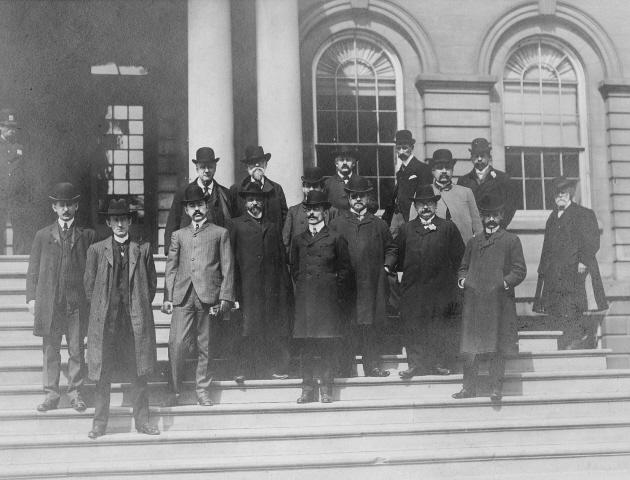
We offered a book prize for the best attempt by a reader to identify the above figures in a photograph forwarded by David DeLucia (Darien, CT, USA). It was a difficult task, even though some masters, such as Marshall, Janowsky, Teichmann and Schlechter, are immediately recognizable and even though, as will be seen, the photograph concerns a famous tournament.
The winner of our contest is Dominique Thimognier (Fondettes, France), and we can do no better than paraphrase his excellent entry, which identifies virtually the entire group.
The photograph shows players in, and organizers of, Cambridge Springs, 1904. Newspaper reports of the time mentioned by Mr Thimognier relate that eight players (Lasker, Chigorin, Teichmann, Janowsky, Schlechter, Marco, Lawrence and Marshall), accompanied by the treasurer of the Carlsbad Club, Victor Tietz, arrived in the United States on the Pretoria. (Mieses followed a few days later on the Graf Waldersee.) This account of their reception appeared on page 16 of the New York Daily Tribune, 19 April 1904:
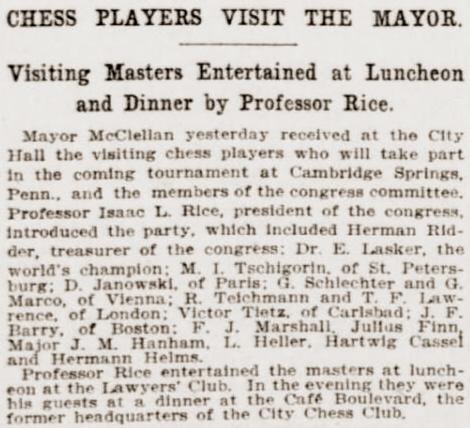
Mr Thimognier also points out that an Internet search confirms that the building in the photograph is the New York City Hall. He offers the following key:
Foreground (left to right): J. Finn, F.J. Marshall, J.F. Barry, M. Chigorin, D. Janowsky, R. Teichmann, V. Tietz, C. Schlechter and J.M. Hanham.
Background (left to right): H. Ridder, I.L. Rice, Em. Lasker, H. Cassel, T.F. Lawrence, G. Marco and N.N. (L. Heller?).
(6891)
C.N. 6683 referred to the Pearl of Zandvoort, but a less familiar term occurs on page 61 of One Move and You’re Dead by Erwin Brecher and Leonard Barden (London, 2007). The conclusion of Janowsky v Schlechter, London, 1899 is given, with the comment that White ‘forced checkmate with such an impressive move that they called it The pearl of St Stephen’s after the London hall where the tournament was played’.
Wanted: other sightings of the term.
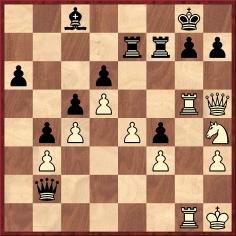
The game ended 34 Qxh7+ Kxh7 35 Rh5+ Kg8 36 Ng6 Resigns.
(7059)
More information is sought about the circumstances in which these games were played (at the Associazione Scacchistica Milanese):
A. Noto – Carl Schlechter1 e4 c5 2 Nf3 e6 3 Nc3 Nc6 4 d4 cxd4 5 Nxd4 Nf6 6 Nxc6 bxc6 7 e5 Nd5 8 Ne4 d6 9 c4
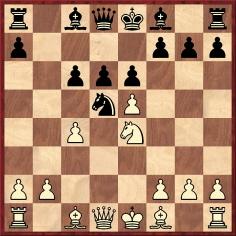
9...dxe5 10 cxd5 exd5 11 Ng3 h5 12 h4 g6 13 Be2 Bg7 14 Qc2 Bd7 15 Bg5 Qb6 16 O-O O-O 17 Rfe1 e4 18 Rad1 Qxb2 19 Qxb2 Bxb2 20 Nxe4 f6 21 Be3 Be5 22 Nc5 Bc8 23 Bf3 Rb8 24 Rb1 Bf5 25 Rxb8 Rxb8 26 Rd1 Rb2 27 g3 Kf8 28 a4 Ke7 29 a5 Kd6 30 a6 Bc8 31 Kg2 Rb5 32 Rc1 d4
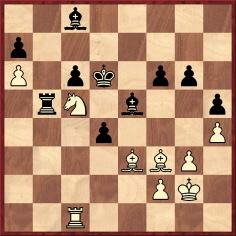
33 Ne4+ Kc7 34 Bf4 Bxf4 35 gxf4 f5 36 Nf6 c5 37 Be2 Ra5 38 Bc4 Kd6 39 Re1 Ra4 40 Bb5 Resigns.
Source: Deutsche Schachzeitung, June 1901, pages 173-174.
Vincenzo Noto – Carl Schlechter
Milan, 6 June 1901
Nimzowitsch Defence
1 e4 Nc6 2 d4 e5 3 d5 Nce7 4 Nf3 d6 5 c4 f5 6 Nc3 Nf6 7 Bd3 h6 8 Qc2 f4
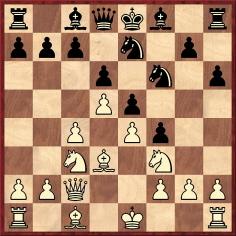
9 Bxf4 exf4 10 e5 dxe5 11 Nxe5 Qd6 12 Bg6+ Nxg6 13 Qxg6+ Ke7 14 Nf7
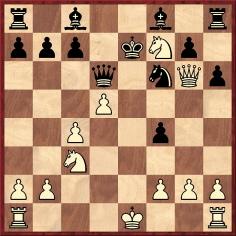
14...Bf5 and wins.
Source: Schweizerische Schachzeitung, October 1901, page 8.
(7788)
Gene Gnandt (Houston, TX, USA) notes an account of Schlechter’s visit to Italy on page 189 of the 8/1901 Nuova Rivista degli Scacchi:
‘Alcune città d’Italia, tra cui Milano e Venezia, hanno avuto il piacere nel passato Giugno di ospitare l’illustre maestro Carlo Schlechter di Vienna, reduce da i suoi trionfi e avventure di Montecarlo. A Venezia la mancanza in quella città del presidente del Circolo comm. Vergara, e dell’avv. Salvioli, ha portato la non lieta conseguenza che il valente scacchista non ha potuto ricevere l’accoglienza che si meritava. Ad ogni modo sappiamo che ha giocato con molti dilettanti di quella città e ha giocato con rara facilità, non disdegnando rompere una lancia con avversari a lui ben inferiori. Una qualità questa ben preziosa in un maestro di primo rango. Il gioco dello Schlechter fu trovato addirittura meraviglioso, e sebbene egli per avventura nei giorni in cui fu in Venezia non abbia potuto trovare alcun avversario degno di stargli a fronte, pure ha saputo dimostrare egualmente quelle splendide qualità di giocatore che fanno di lui uno dei primissimi campioni moderni. In Milano invece egli colse un momento più propizio. Giocò alcune belle partite col V. Noto, e potè essere festeggiato in modo più degno del suo nome.’
We add that according to page 8 of the October 1901 Schweizerische Schachzeitung the 1 e4 Nc6 game in C.N. 7788 had previously appeared in the Eco degli scacchi (Palmero).
(7793)
Page 42 of Evans on Chess by Larry Evans (New York, 1974):
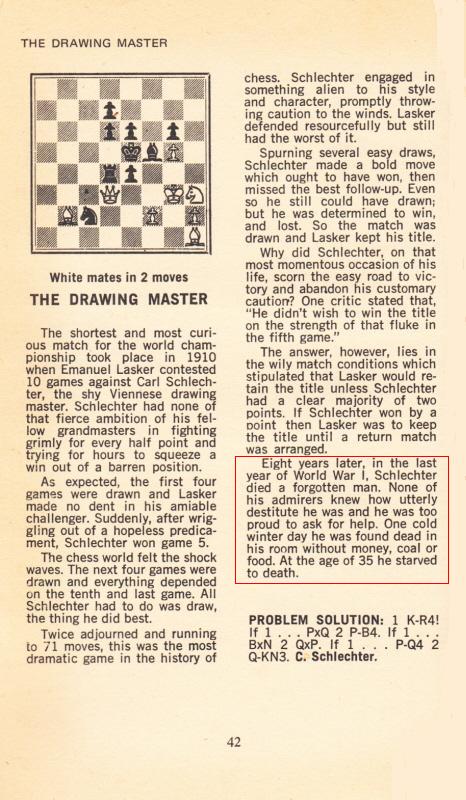
As regards the final paragraph, at the time of his death, in late December 1918, Schlechter was by no means ‘forgotten’; he was the Editor of the Deutsche Schachzeitung and in September-October 1918 had participated in a double-round tournament in Berlin with Lasker, Rubinstein and Tarrasch. His death occurred not ‘in the last year of World War I’ but after the War was over. Nor was he found dead alone in his room at home (which would mean in Vienna); he died in hospital in Budapest. The cause of his death is uncertain. He was then aged 44, not 35.
That syndicated column by Evans, riddled with errors though it was, was still appearing in newspapers nearly 15 years after its first publication (on, for instance, page D27 of the Chicago Tribune, 3 May 1987), without even a correction of Schlechter’s age.
Nor, of course, was there ever an admission that the article was heavily reliant on a piece about Schlechter by Heinrich Fraenkel published on pages 50-53 of Chess Treasury of the Air by Terence Tiller (Harmondsworth, 1966) and reprinted on pages 5-6 of the January 1970 Chess Digest. Below is the final paragraph from the book:
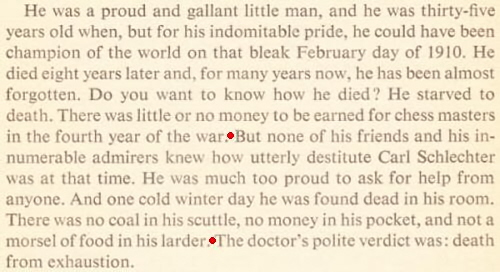
It is obviously unwise to rely on such material without independent corroboration, but Evans relied on it without even reading it properly. Fraenkel stated, correctly, that Schlechter was aged 35 at the time of the match against Lasker, and not when he died, and he referred to Schlechter being almost forgotten ‘for many years now’ (i.e. from the standpoint of the mid-twentieth century), and not at the time of his death.
Despite cribbing from Fraenkel, Evans contradicted him concerning the terms of the Lasker v Schlechter match (for Fraenkel was the ‘critic’ mentioned anonymously three paragraphs from the end of Evans’ article). He also wrote simplistically and categorically about the match on page 49 of The Chess Beat, again with no apparent understanding of what is one of the most complex puzzles in chess history. It is not by chance that criticism of Evans’ published output increased during his later years, as he eschewed writing about chess play (in which he held the grandmaster title) and preferred writing about chess history, lore and politics (in which he held himself up to ridicule).
On pages 45-50 of Carl Schlechter! Life and Times of the Austrian Chess Wizard (Yorklyn, 1994) Warren Goldman discussed Schlechter’s demise in detail, noting that possible causes of death were lung disease aggravated by lack of proper nutrition, tuberculosis, pneumonia and the Spanish flu epidemic. On page 46 he wrote:
‘Published accounts concerning the medical details are fragmentary and do not allow a firm conclusion as to the precise cause of death.’
Pages 428-452 of the Goldman book sifted the evidence regarding the conditions for the 1910 Lasker v Schlechter match. Again, no definitive conclusions could be offered.
That is how proper writers (not only historians, of course) work. When they know, they explain why they know. When they are uncertain, they explain why they are uncertain. When they do not know, they either say that they do not know or they say nothing. That is honest writing which treats the reader with respect, and there is no other kind worth doing.
(8222)
‘He was widely known throughout his career as a drawing master, usually content to split the point even with much weaker players, but very difficult to beat.’
Source: The World Chess Championship A History by Al Horowitz (New York, 1973), page 63. (Almost identical sentiments appeared in Horowitz’s column in the New York Times, 5 March 1972, page D 31.)
‘The designation “drawing master” for Carl Schlechter can be taken with a grain of salt.’
Source: Solitaire Chess by Al Horowitz (New York, 1962), page 69. (The item originally appeared on page 209 of the July 1960 Chess Review.)
(8506)
From page 58 of Blunders and Brilliancies by Ian Mullen and Moe Moss (Oxford, 1990):
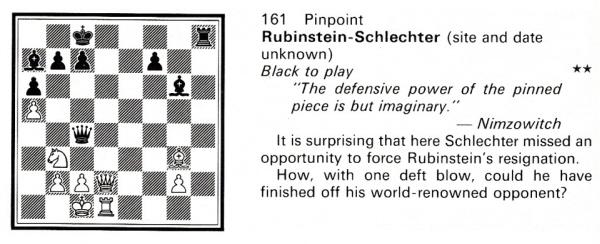
The co-authors did not state their source for the position. Such a finish (with the move ...Be3 overlooked) did occur in a game (Berlin, 1918) between the players named, but Schlechter was White. The position, moreover, was slightly different:
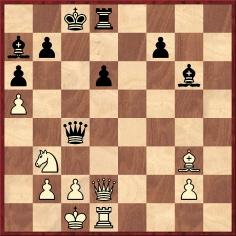
The game was annotated by Emanuel Lasker (who mentioned the players’ extreme time-trouble at move 30) on pages 14-15 of Das Großmeister-Turnier im Kerkau-Palast zu Berlin im Oktober 1918:
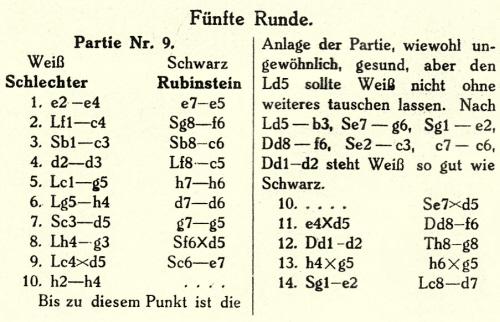
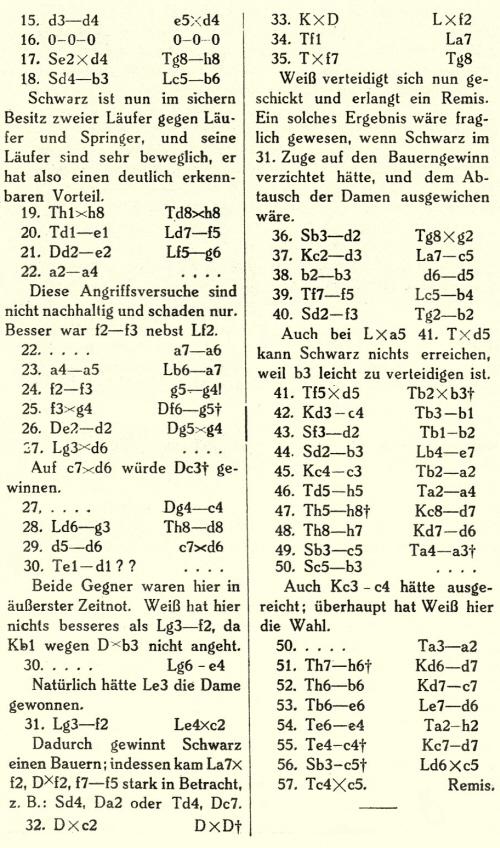
See too page 321 of volume one of The Life & Games of Akiva Rubinstein by John Donaldson and Nikolay Minev (Milford, 2006).
(8715)
Page 181 of Schachjahrbuch für 1905 II. Teil by L. Bachmann (Ansbach, 1906):
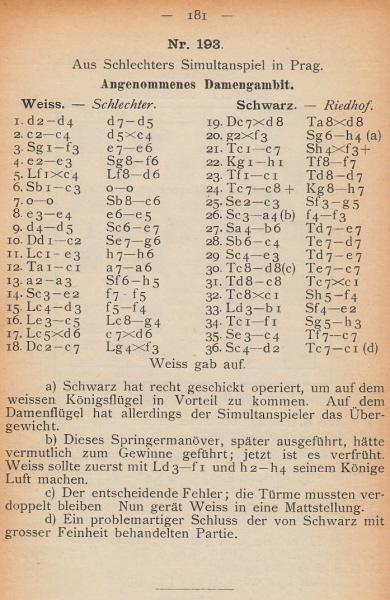
1 d4 d5 2 c4 dxc4 3 Nf3 e6 4 e3 Nf6 5 Bxc4 Bd6 6 Nc3 O-O 7 O-O Nc6 8 e4 e5 9 d5 Ne7 10 Qc2 Ng6 11 Be3 h6 12 Rac1 a6 13 a3 Nh5 14 Ne2 f5 15 Bd3 f4 16 Bc5 Bg4 17 Bxd6 cxd6
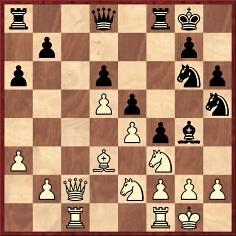
18 Qc7 Bxf3 19 Qxd8 Raxd8 20 gxf3 Nh4 21 Rc7 Nxf3+ 22 Kh1 Rf7 23 Rfc1 Rdd7 24 Rc8+ Kh7 25 Nc3 Ng5 26 Na4 f3 27 Nb6 Rde7 28 Nc4 Rd7 29 Ne3 Rde7 30 Rd8 Rc7 31 Rc8 Rxc1+ 32 Rxc1 Nf4 33 Bb1 Ne2 34 Rf1 Nh3 35 Nc4 Rc7 36 Nd2
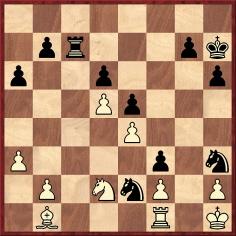
36...Rc1 37 White resigns.
Details are sought. The news item below comes from page 188 of the June 1905 Deutsche Schachzeitung.

(8723)
Peter Anderberg (Harmstorf, Germany) has found the Schlechter v Riedhof score on page 25 of Bohemia, 28 May 1905, together with three other games played by Schlechter in the same simultaneous exhibition (which was on 22 May, and not 21 May as stated in the Deutsche Schachzeitung news item reproduced in C.N. 8723).
First, a general report, from page 7 of Bohemia (morning edition), 25 May 1905:

Below are the games as published by Bohemia on 28 May 1905:
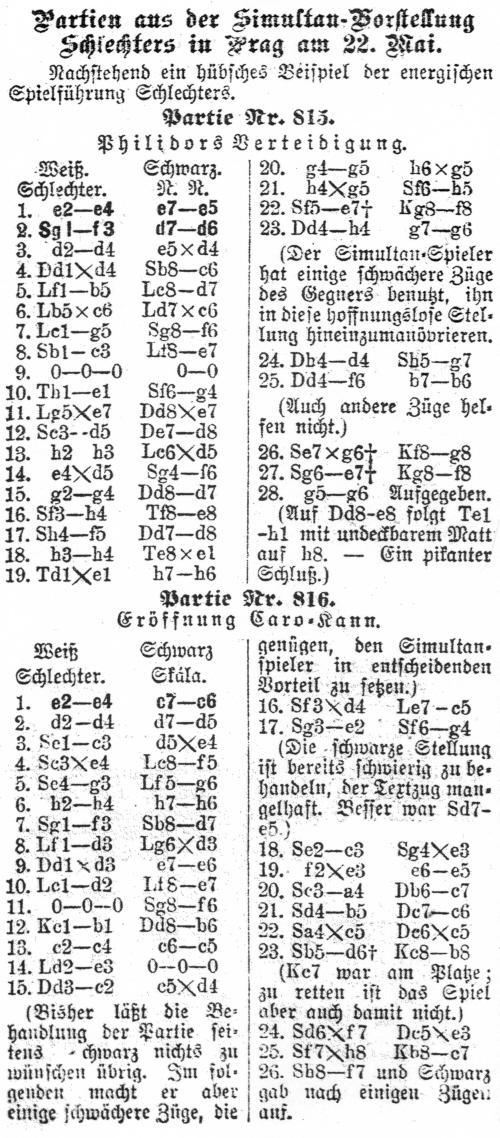
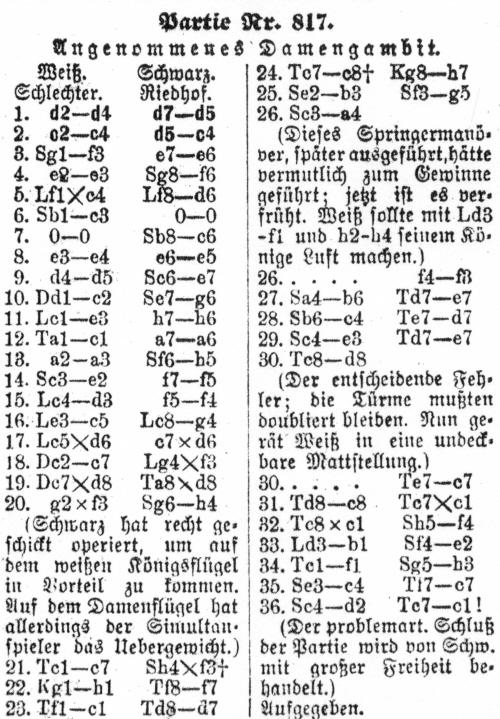
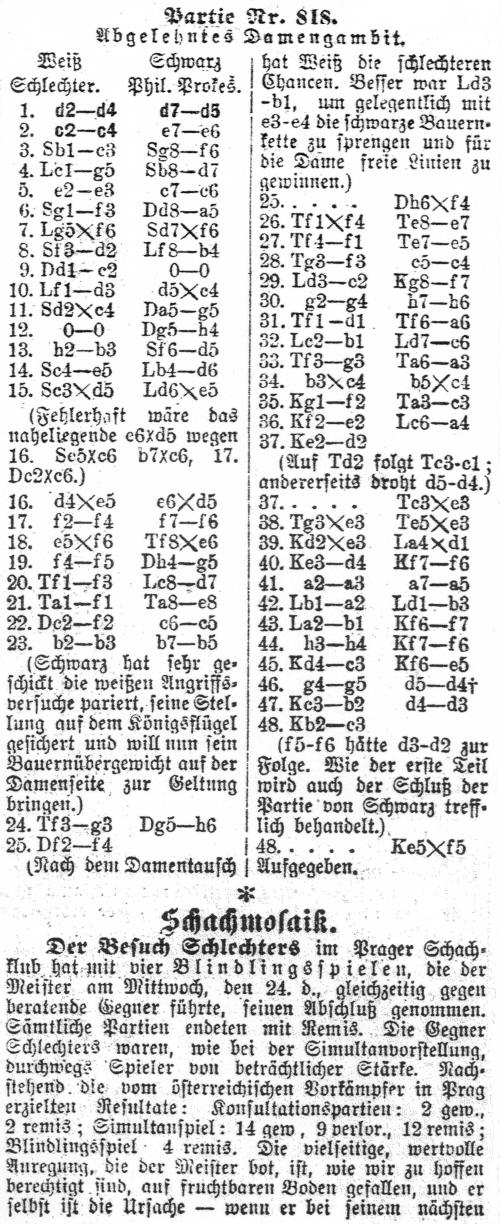

Carl Schlechter – N.N.
Prague, 22 May 1905
Philidor’s Defence
1 e4 e5 2 Nf3 d6 3 d4 exd4 4 Qxd4 Nc6 5 Bb5 Bd7 6 Bxc6 Bxc6 7 Bg5 Nf6 8 Nc3 Be7 9 O-O-O O-O 10 Rhe1 Ng4 11 Bxe7 Qxe7 12 Nd5 Qd8 13 h3 Bxd5 14 exd5 Nf6 15 g4 Qd7 16 Nh4 Rfe8 17 Nf5 Qd8 18 h4 Rxe1 19 Rxe1 h6 20 g5 hxg5 21 hxg5 Nh5 22 Ne7+ Kf8
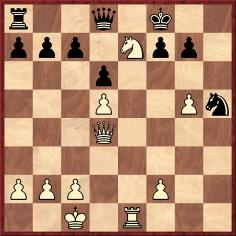
23 Qh4 g6 24 Qd4 Ng7 25 Qf6 b6 26 Nxg6+ Kg8 27 Ne7+ Kf8 28 g6 Resigns.
Carl Schlechter – Skála
Prague, 22 May 1905
Caro-Kann Defence
1 e4 c6 2 d4 d5 3 Nc3 dxe4 4 Nxe4 Bf5 5 Ng3 Bg6 6 h4 h6 7 Nf3 Nd7 8 Bd3 Bxd3 9 Qxd3 e6 10 Bd2 Be7 11 O-O-O Ngf6 12 Kb1 Qb6 13 c4 c5 14 Be3 O-O-O 15 Qc2 cxd4 16 Nxd4 Bc5 17 Nge2 Ng4 18 Nc3 Nxe3 19 fxe3 e5
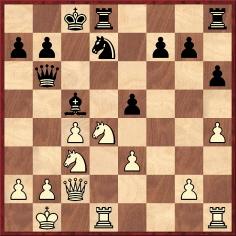
20 Na4 Qc7 21 Nb5 Qc6 22 Nxc5 Qxc5 23 Nd6+ Kb8 24 Nxf7 Qxe3 25 Nxh8 Kc7 26 Nf7 Resigns.
Carl Schlechter – Ladislav Prokeš
Prague, 22 May 1905
Queen’s Gambit Declined
1 d4 d5 2 c4 e6 3 Nc3 Nf6 4 Bg5 Nbd7 5 e3 c6 6 Nf3 Qa5 7 Bxf6 Nxf6 8 Nd2 Bb4 9 Qc2 O-O 10 Bd3 dxc4 11 Nxc4 Qg5 12 O-O Qh4 13 h3 Nd5 14 Ne5 Bd6 15 Nxd5 Bxe5 16 dxe5 exd5 17 f4 f6 18 exf6 Rxf6 19 f5 Qg5 20 Rf3 Bd7 21 Raf1 Re8 22 Qf2 c5 23 b3
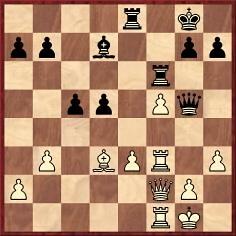
23...b5 24 Rg3 Qh6 25 Qf4 Qxf4 26 Rxf4 Re7 27 Rf1 Re5 28 Rgf3 c4 29 Bc2 Kf7 30 g4 h6 31 Rd1 Ra6 32 Bb1 Bc6 33 Rg3 Ra3 34 bxc4 bxc4 35 Kf2 Rc3 36 Ke2 Ba4 37 Kd2 Rcxe3 38 Rxe3 Rxe3 39 Kxe3 Bxd1 40 Kd4 Kf6 41 a3 a5 42 Ba2 Bb3 43 Bb1 Kf7 44 h4 Kf6 45 Kc3 Ke5 46 g5 d4+ 47 Kb2 d3 48 Kc3 Kxf5 49 White resigns.
(8734)
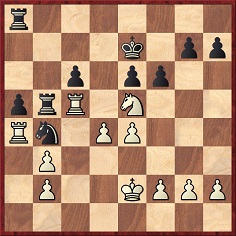
Position after 21...f6
White played 22 Rxb4 (Schlechter v Perlis, Carlsbad, 1911).
On page 39 of Chess Strategy and Tactics (New York, 1933) Fred Reinfeld and Irving Chernev wrote:
‘22 RxKt!?
A remarkable case of “chess blindness”: Schlechter is so concentrated on the logical result of his beautiful play from the 14th move on, that he completely overlooks the simple win of the exchange by 22 KtxPch. Strangely enough, Dr Tarrasch was the only annotator to point out this move.’
Such ‘only annotator’ claims are risky.
We have yet to find a complete set of notes by Tarrasch to the Schlechter v Perlis game, but he discussed the above position in ‘Über Schachblindheit (Amaurosis scachistica)’, in his book Die moderne Schachpartie. The article was reproduced in full in C.N. 8187.
It is true that shortly after the game was played a number of annotators praised 22 Rxb4. It received an exclamation mark in, for instance, the Deutsche Schachzeitung (September 1911, page 268) and the BCM (October 1911, page 395).
Spielmann’s notes to the game in the Münchner Neuesten Nachrichten were given on pages 402-403 of La Stratégie, November 1911, and the original German was reproduced on pages 116-118 of Schachjahrbuch für 1911 I. Teil by L. Bachmann (Ansbach, 1912). Here too 22 Rxb4 received an exclamation mark, but Spielmann later changed his mind, criticizing the move when annotating the game on pages 134-135 of his monograph Karl Schlechter (Stockholm, 1924):
‘22 Ta4xb4?
Ett av dessa psykologiskt intressanta fall av ömsesidig hypnos, eller som dr Tarrasch skämtsamt benämner det, “schackblindhet”. 22 Sxc6† hade varit att ge motståndaren nådestöten, medan nu partiet blott står att vinna genom ett subtilt tornslutspel.’
However, the claim by Reinfeld and Chernev about Tarrasch being the ‘only annotator’ is invalidated by the fact that the Wiener Schachzeitung (September-October 1911, page 316) criticized 22 Rxb4: ‘Ein Kuriosum; Schlechter übersieht, daß er mit 22 Se5xc6 viel rascher entscheiden konnte.’
On page 38 of part one of Vidmar’s Carlsbad, 1911 tournament book 22 Rxb4 received a question mark and a terse note: ‘Warum nicht Sc6†?’
(9420)
Peter Anderberg points out that Tarrasch annotated the full Schlechter v Perlis game on pages 238-239 of Die Schachwelt, 12 September 1911 and stated that at move 22 White should have played Nxc6+ instead of Rxb4.
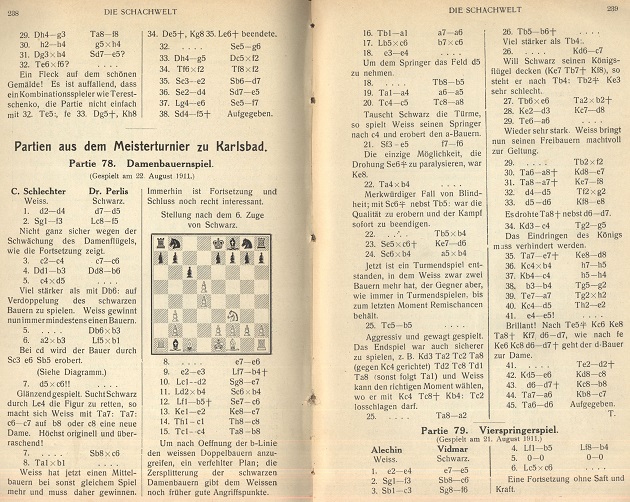
C.N. 9420 mentioned that the September-October 1911 Wiener Schachzeitung also criticized 22 Rxb4, but, as Mr Anderberg notes, page 267 of that issue indicated that it was not published until December.
(9443)
The frontispiece to Der Schachwettkampf Schlechter-Tarrasch (Leipzig, 1912):
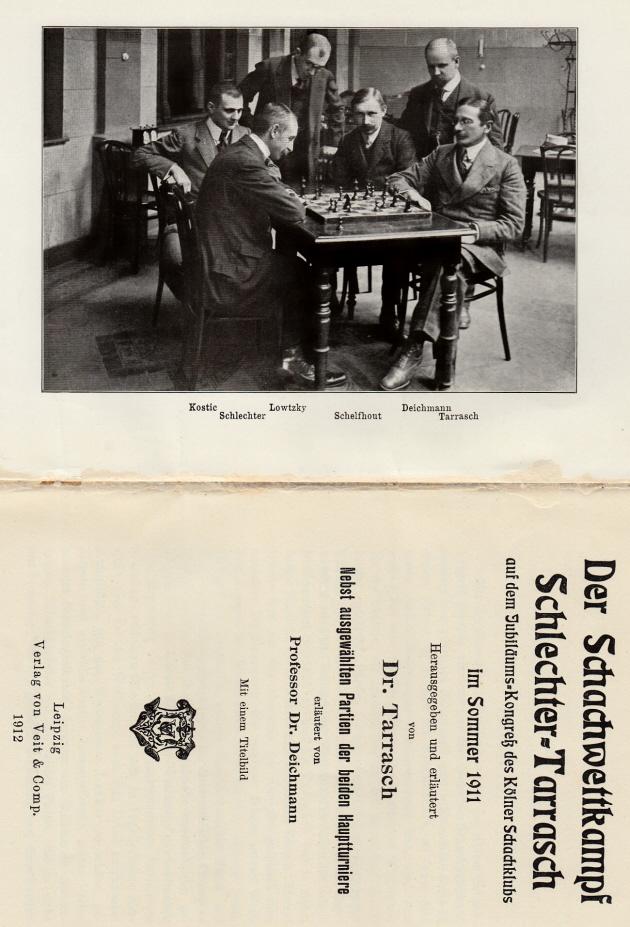
(8738)
From Jan Kalendovský (Brno, Czech Republic):
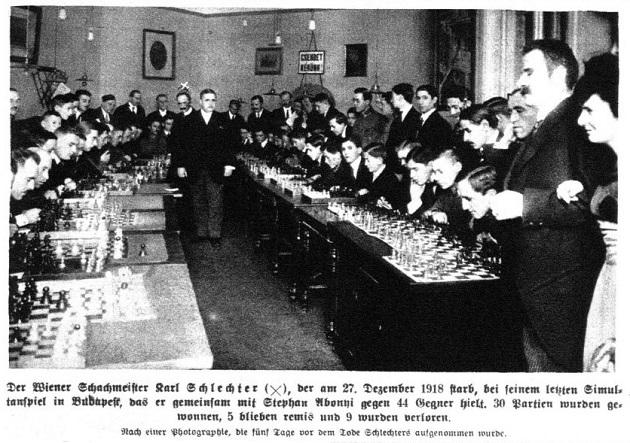
Wiener Bilder, 26 January 1919, page 11
(9671)
The group photograph of Budapest, 1896 is fairly well known – see, for instance, page 5 of John C. Owen’s tournament book (Yorklyn, 1994) – but a particularly good version was published on page 793 of the 22 November 1896 edition of Vasárnapi Ujság (with Marco and Maróczy’s names transposed):
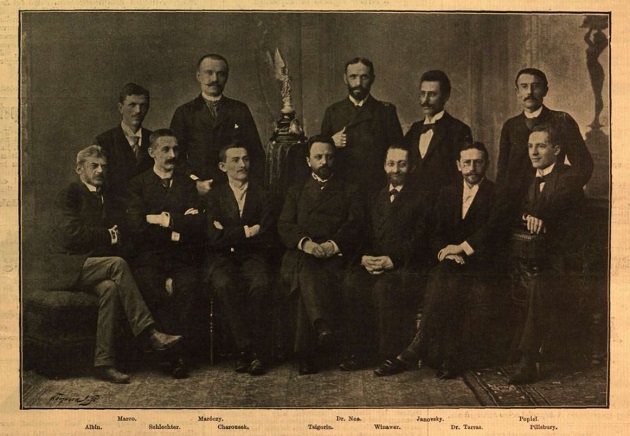
(10913)
James Lanning (Bloomington, IN, USA) draws attention to this curious passage on page 442 of Die hypermoderne Schachpartie by Savielly Tartakower (Vienna, 1924):

Tartakower’s essay in Spielmann’s monograph on Schlechter is given below in full. It appeared under the pseudonym ‘Spielmann’ in the sense that it was in Spielmann’s book without any indication of authorship, thus leaving readers to assume that the three and a half pages were by Spielmann himself.
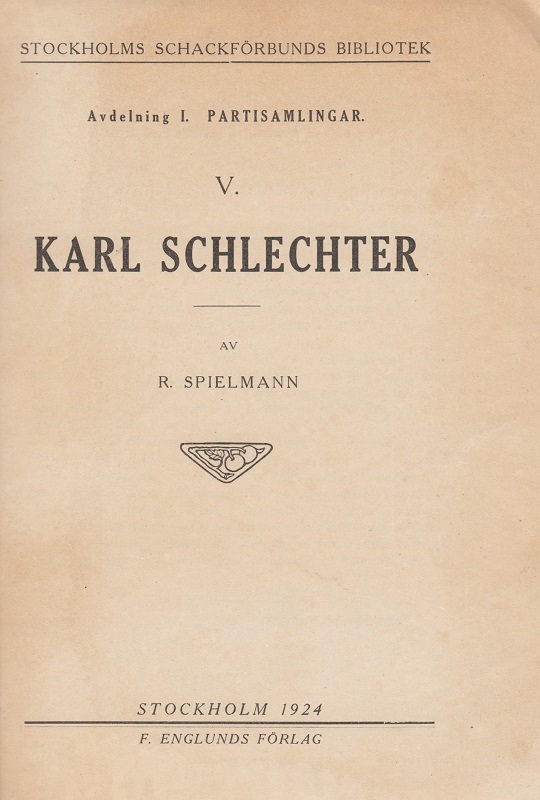
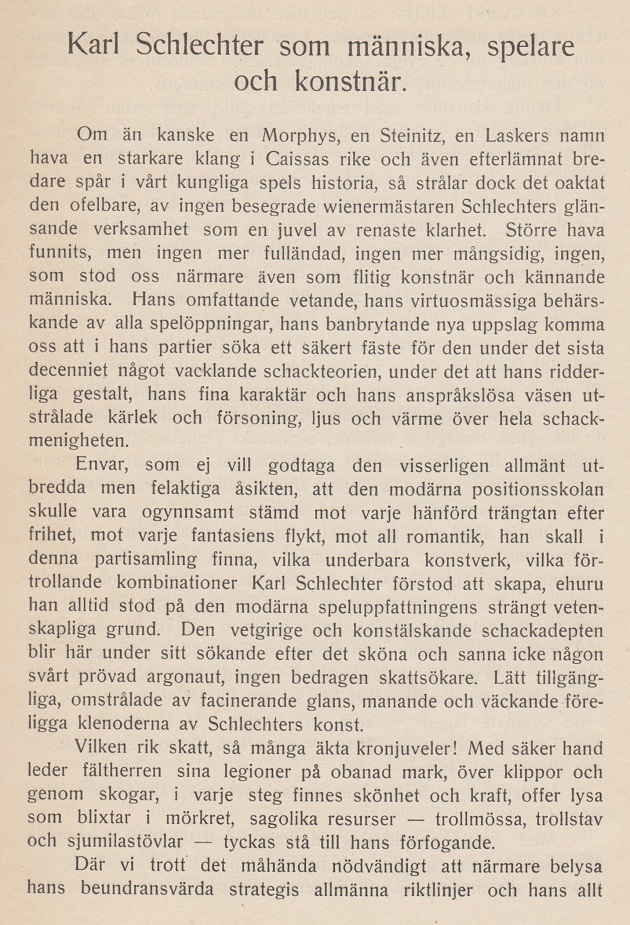
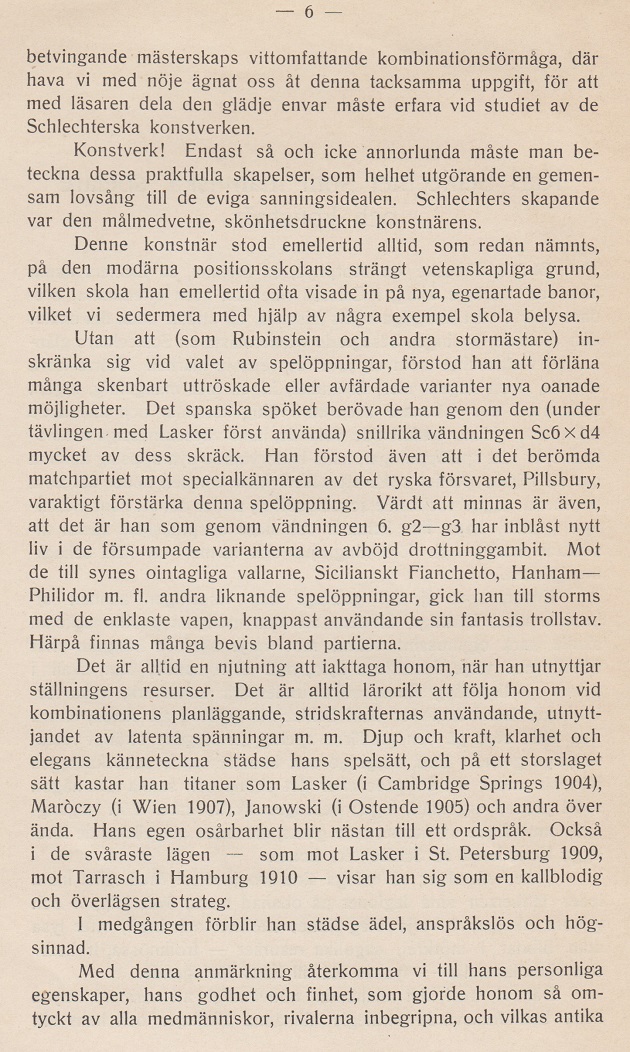
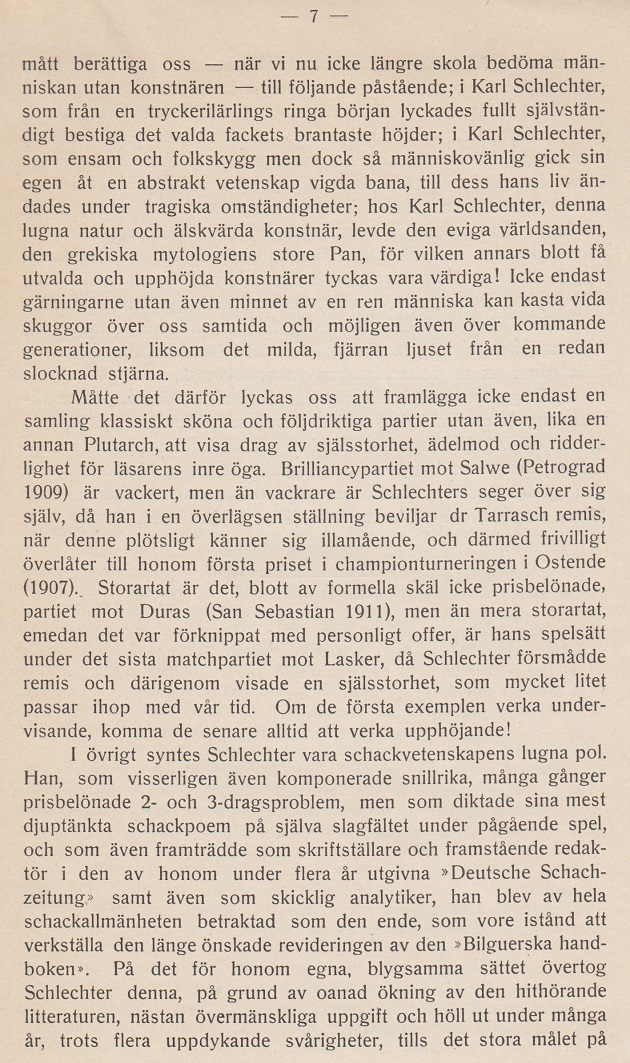
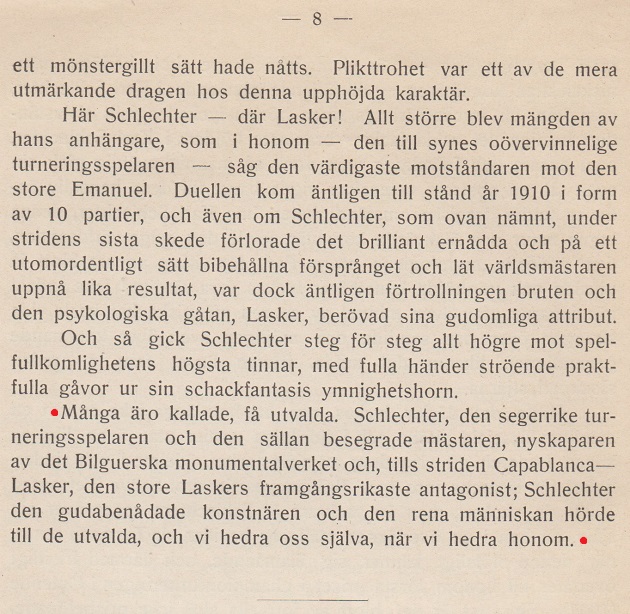
The passage in Die hypermoderne Schachpartie mentioned by our correspondent was mistranslated in the disastrous English edition (see C.N.s 9701 and 10408) of Tartakower’s book, The Hypermodern Game of Chess (Milford, 2015):
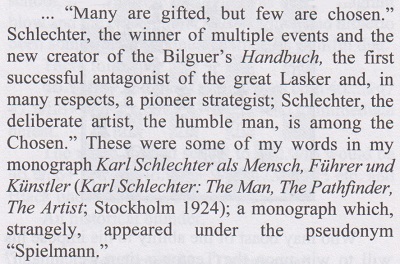
(10915)
From page 190 of the December 1898 Wiener Schachzeitung:

This photograph is on page 8 of Das interessante Blatt, 22 December 1898:
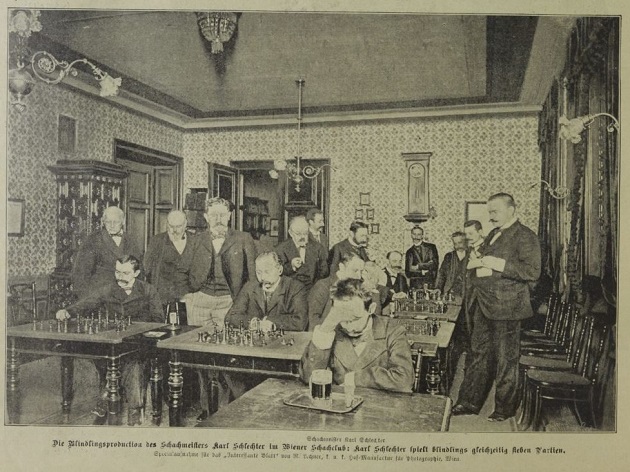
(11320)
A photograph of F.D. Yates and C. Schlechter at Hamburg, 1910 has been supplied by Jan Kalendovský, courtesy of Zdenĕk Závodný:
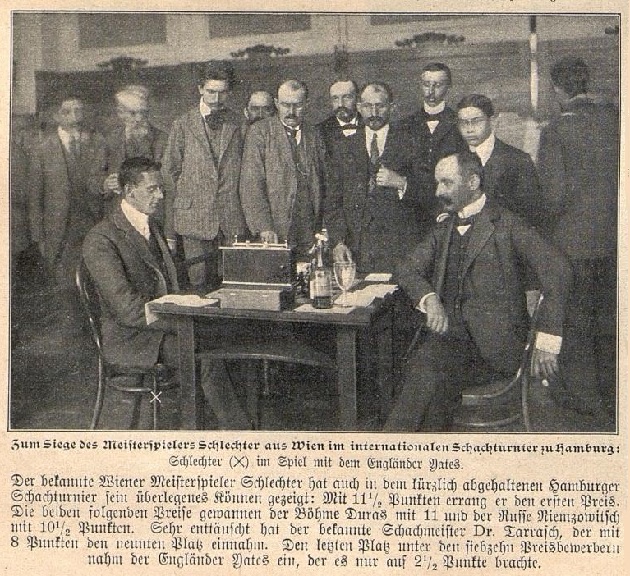
Source: Deutsche Frauen- und Modezeitung, 22/1910, page 12.
(11338)
From page 189 of The Golden Treasury of Chess by Francis J. Wellmuth (Philadelphia and New York, 1943):
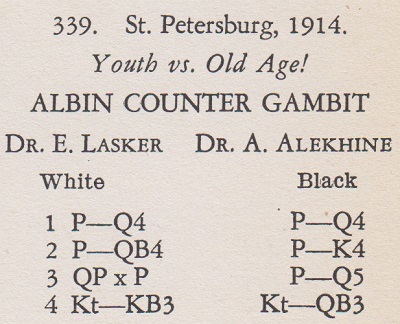
Lasker was aged 45.
The ‘Youth vs. Old Age!’ heading remained in Al Horowitz’s editions of the Treasury (game 190).
The annotations by Fred Reinfeld to Schlechter’s win over Alekhine at Carlsbad, 1911 concluded on page 120 of The Unknown Alekhine 1905-1914 (London and New York, 1949) with this remark:
‘For once, old age conquered youth.’
As pointed out in C.N. 643 (see page 147 of Chess Explorations), Schlechter was 37.
(11352)
From Street Names with Chess Connections:
James Bell Cooper (Vienna) sends the following photograph taken in his home city:

Rainer Smeykal (Munich, Germany) reports that his copy of Karl Schlechter by R. Spielmann (Stockholm, 1924) has a postcard inscribed by a member of Schlechter’s family the year after he died:
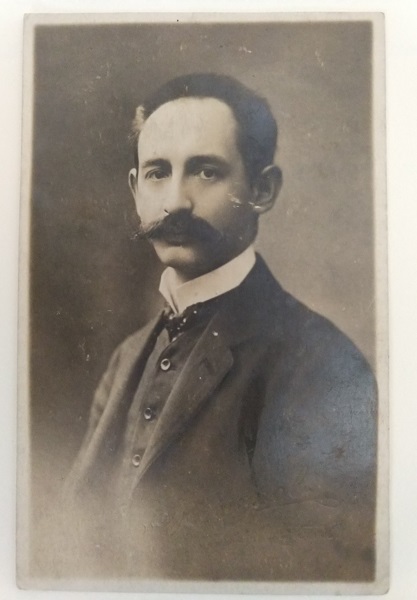
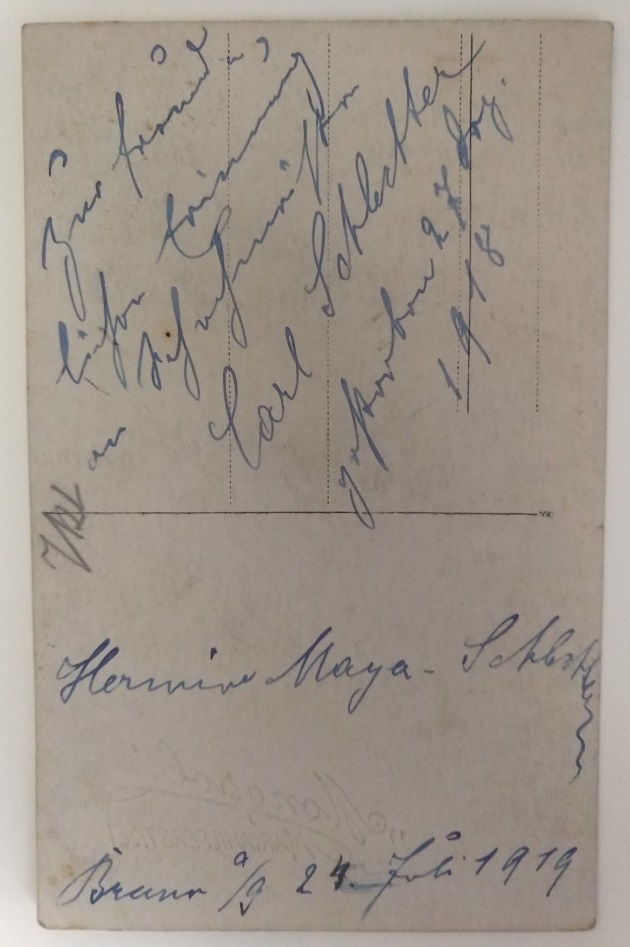
‘Zur freundlichen Erinnerung an Schachmeister Carl Schlechter gestorben 27 Dez. 1918.
Hermine Mayer-Schlechter
Brunn [am Gebirge] 24. Juli 1919.’
Mr Smeykal notes that the photograph and a similar caption (translated into English) are on page 50 of Warren Goldman’s monograph on Schlechter. On the basis of information on pages 13-15 of that book, our correspondent takes Hermine Mayer-Schlechter to be the master’s aunt.
(11461)
From John Nunn (Bude, England):
‘I was looking at the game Blackburne-Schlechter, Vienna, 1898, which is actually an interesting example of a knight being superior to a bishop in an ending with a relatively open position. The score given by ChessBase is as follows:
1 e4 e5 2 f4 exf4 3 Bc4 d5 4 exd5 Qh4+ 5 Kf1 Bd6 6 Nf3 Qh5 7 Nc3 Ne7 8 d4 Bg4 9 Ne4 Nxd5 10 Nxd6+ cxd6 11 Qe1+ Be6 12 Bb5+ Nd7 13 c4 Ne3+ 14 Bxe3 fxe3 15 d5 Bg4 16 Qxe3+ Kd8 17 Re1 Kc7 18 Bxd7 Bxd7 19 Kf2
19...Rae8 20 Qf4 Qf5 21 Qxf5 Bxf5 22 Nd4 Bg6 23 Rxe8 Rxe8 24 Re1 Rxe1 25 Kxe1 Bd3 26 b3 Kd7 27 Kd2 Be4 28 g3 Bb1 29 a3 Be4 30 Ke3 Bb1 31 Nf3 Ke7 32 b4 Bf5 33 c5 Bd7 34 Kd4 Be8 35 Nd2 Bd7 36 Nc4 dxc5+ 37 bxc5 f6 38 Nb2 Bf5 39 a4 Kd7 40 a5 a6 41 Nc4 Kc7 42 Nd6 Bd7 43 Ke4 Ba4 44 g4 Bc2+ 45 Kd4 Bg6 46 h3 Kb8 47 Nf5 Bxf5 48 gxf5 Kc7 49 Ke4 Kd7 50 Kf4 Ke7 51 Kg4 Kd7 52 h4 Kc8 53 h5 h6 54 Kf4 Kc7 55 Ke4 1-0.
I just had a suspicion that instead of 19...Rae8, Black actually played 19...Rhe8. There seems no reason to offer the a-pawn, and indeed White can easily make off with an extra pawn by taking it (meeting ...Ra8 by Qd4 attacking g7).
I couldn’t find anything about the game online and I don’t have the tournament book. If possible, I would be grateful if you could check to see which move was actually played.’
We find the evidence mixed.
Firstly, the tournament book gives 19...Rae8 (scans below courtesy of the Cleveland Public Library):
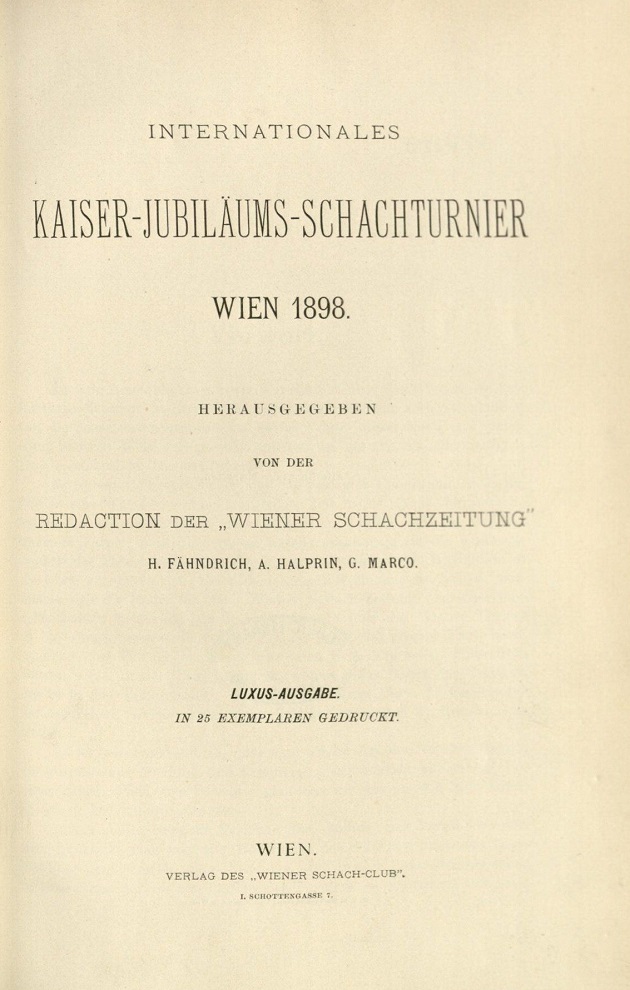
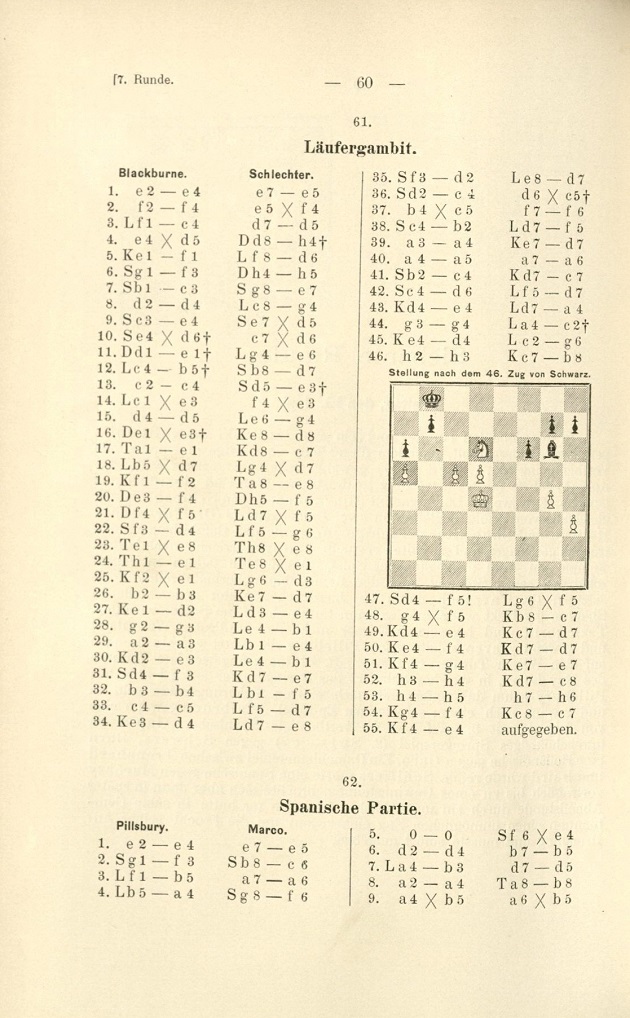
However, on page 923 of The Field, 18 June 1898 Hoffer gave 19...Rhe8 (without comment), as did pages 230-232 of the August 1898 Deutsche Schachzeitung.
Page 379 of Tim Harding’s monograph on Blackburne mentioned the above three sources, noting a number of discrepancies in the game-score (although not the one at move 19, where ...Rae8 was given).
In addition to welcoming further evidence from readers concerning the Rae8/Rhe8 matter, we offer a few thoughts on the difficulties faced by writers:
1) There are so many discrepancies in game-scores, and such a plethora of sources potentially to be checked, that it is unrealistic to expect chess books of any kind, however specialized, to document all such instances;
2) Discrepancies of particular note (e.g. in Ed. Lasker v Thomas and Morrison v Capablanca) should be mentioned as a matter of course. That principle also applies to such issues as the dating of games. A writer unsure whether a game was played in, say, 1900 or 1901, should simply share the uncertainty with readers (‘1900 or 1901’) and not plump for one possible date and hope for the best. Acknowledging one’s uncertainty is a sign of strength, not weakness.
3) How databases should handle contradictory information is a separate question which we diffidently leave aside, at least for now.
(11916)
Olimpiu G. Urcan (Singapore) provides a photograph published on page 51 of Az Érdekes Ujsag, 26 December 1918 (the day before Schlechter died):
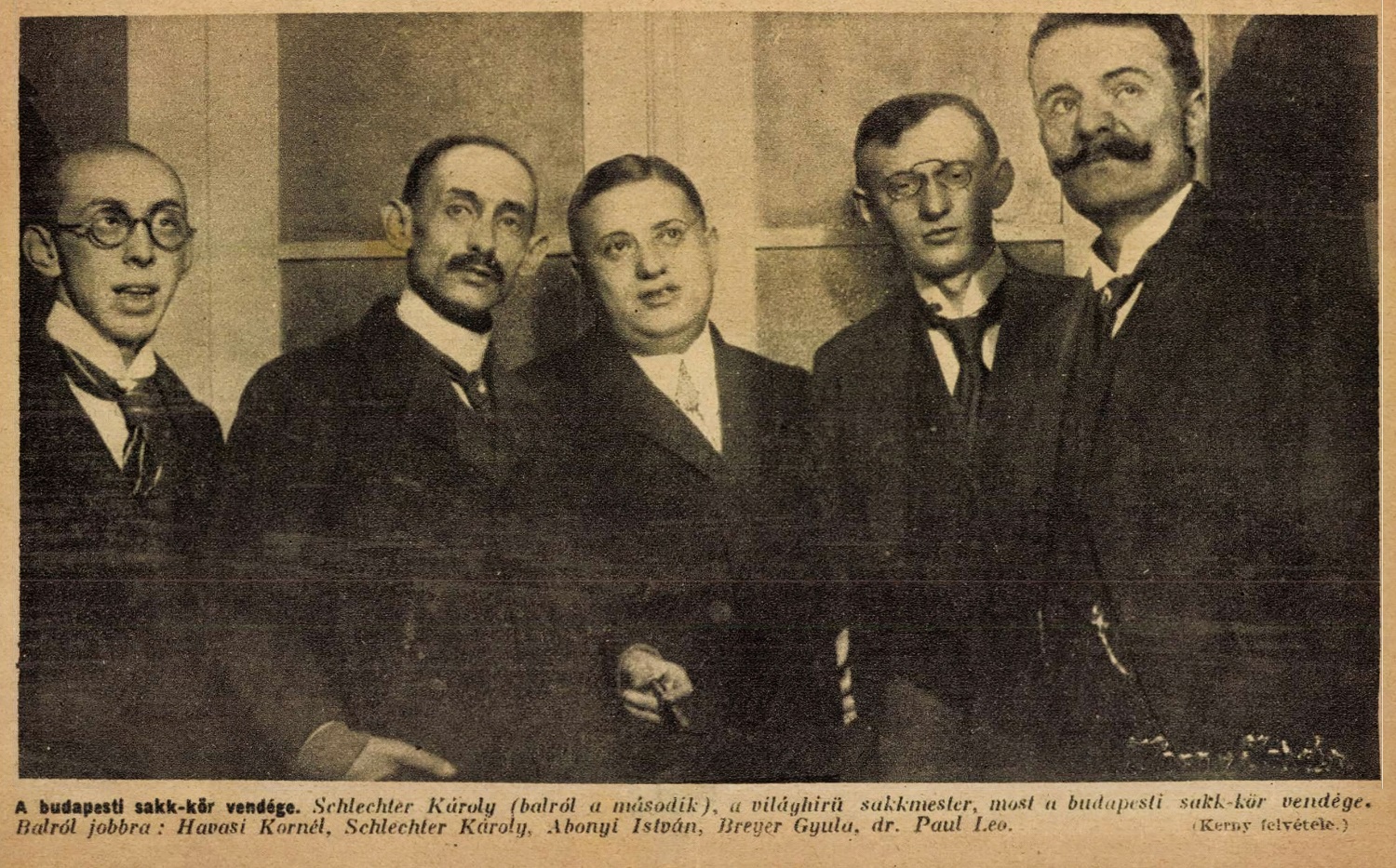
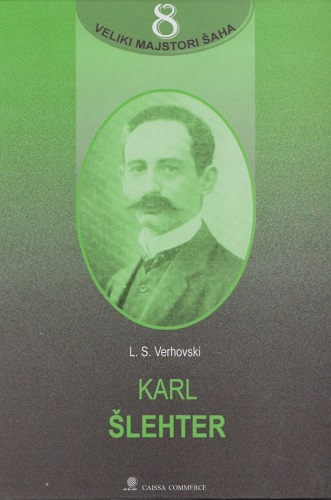
To the Archives
for other feature articles.
Copyright Edward Winter. All rights reserved.